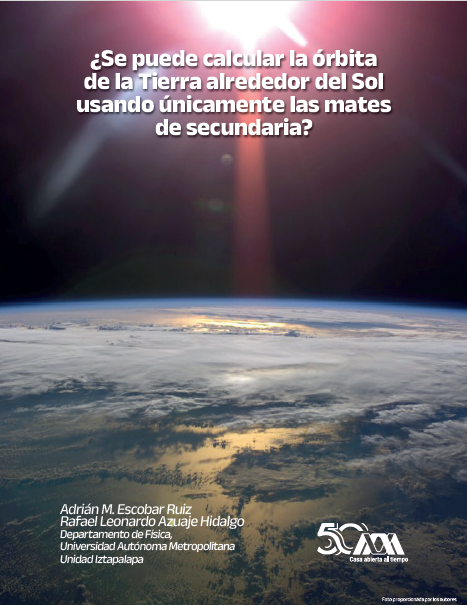¿Se puede calcular la órbita de la Tierra alrededor del Sol usando únicamente las mates de secundaria?
Keywords:
solvability, Hamiltonian systems, conserved quantities, Kepler problem
Abstract
Since Human Beings can see the stars in the sky, they have wanted to understand and describe their movement. Currently we can mathematically describe the movement of celestial objects, as well as other objects in nature. However, this knowledge seems to be restricted to physicists and mathematicians who are experts in the field. In this text we briefly present in an accessible way some ideas and developments that allow us to describe the movement of certain physical systems that we can find in nature, including the movement of celestial objects, using only the mathematical tools regularly taught in secondary education.
Downloads
Download data is not yet available.
References
Abraham R. and Marsden J. E., Foundations of Mechanics. American Mathematical Soc. No. 364, pp 161-199, 2008.
Arnold V. I., Kozlov V. V. and Neishtadt A. I, Mathematical Aspects of Classical and Celestial Mechanics, Third Edition. Springer, pp 30-40, 2006.
Azuaje R., "Solutions of the Hamilton equations for time-dependent Hamiltonian systems by means of solvable Lie algebras of symmetries", Rep. Math. Phys., 89(2), pp. 221–230, 2022.
Escobar-Ruiz A. M. and Azuaje R., "On particular integrability in classical mechanics", J. Phys. A: Math. Theor. 57 105202, 2023.
Escobar-Ruiz A. M., Linares R. and Winternitz P., "New infinite families of Nth-order superintegrable systems separating in Cartesian coordinates", J. Phys. A: Math. Theor. 53 445203, 2020.
Goldstein H., Classical mechanics. Pearson Education, pp. 334-366, 2011.
Miller W. et al., "Classical and quantum superintegrability with applications", J. Phys. A: Math. Theor. 46 423001, 2013.
Turbiner A. V. and Escobar-Ruiz A. M., "Two-body Coulomb problem and hidden g (2) algebra: superintegrability and cubic polynomial algebra", Journal of Physics: Conference Series. Vol. 2667. 012075, 2023.
Arnold V. I., Kozlov V. V. and Neishtadt A. I, Mathematical Aspects of Classical and Celestial Mechanics, Third Edition. Springer, pp 30-40, 2006.
Azuaje R., "Solutions of the Hamilton equations for time-dependent Hamiltonian systems by means of solvable Lie algebras of symmetries", Rep. Math. Phys., 89(2), pp. 221–230, 2022.
Escobar-Ruiz A. M. and Azuaje R., "On particular integrability in classical mechanics", J. Phys. A: Math. Theor. 57 105202, 2023.
Escobar-Ruiz A. M., Linares R. and Winternitz P., "New infinite families of Nth-order superintegrable systems separating in Cartesian coordinates", J. Phys. A: Math. Theor. 53 445203, 2020.
Goldstein H., Classical mechanics. Pearson Education, pp. 334-366, 2011.
Miller W. et al., "Classical and quantum superintegrability with applications", J. Phys. A: Math. Theor. 46 423001, 2013.
Turbiner A. V. and Escobar-Ruiz A. M., "Two-body Coulomb problem and hidden g (2) algebra: superintegrability and cubic polynomial algebra", Journal of Physics: Conference Series. Vol. 2667. 012075, 2023.

Published
2024-12-19
How to Cite
Escobar Ruiz, A. M., & Azuaje Hidalgo, R. L. (2024). ¿Se puede calcular la órbita de la Tierra alrededor del Sol usando únicamente las mates de secundaria?. Contactos, Revista De Educación En Ciencias E Ingeniería, (139), 72 - 81. Retrieved from https://contactos.izt.uam.mx/index.php/contactos/article/view/470
Section
Artículos





